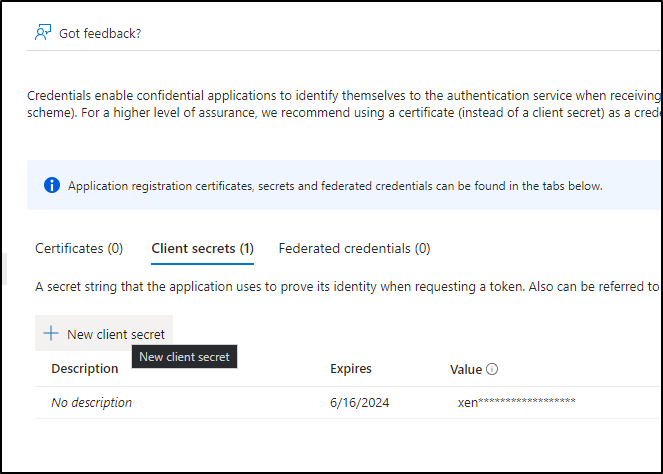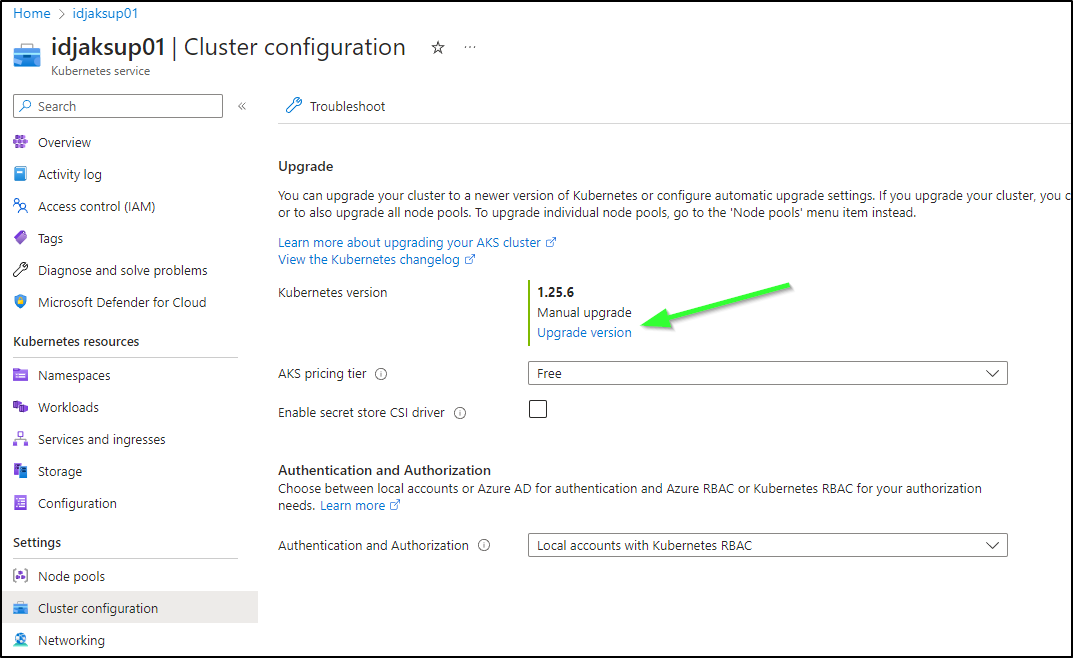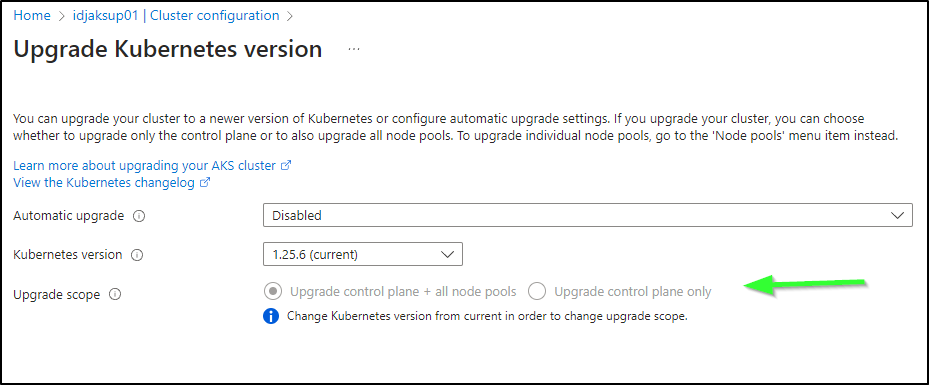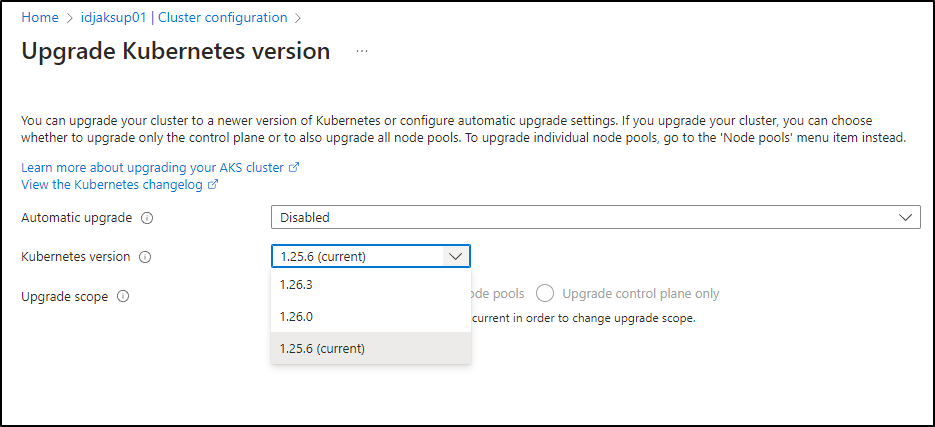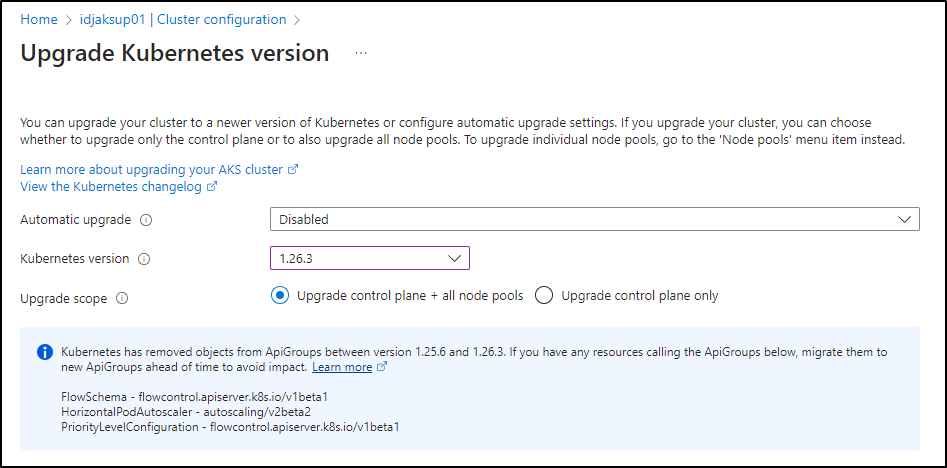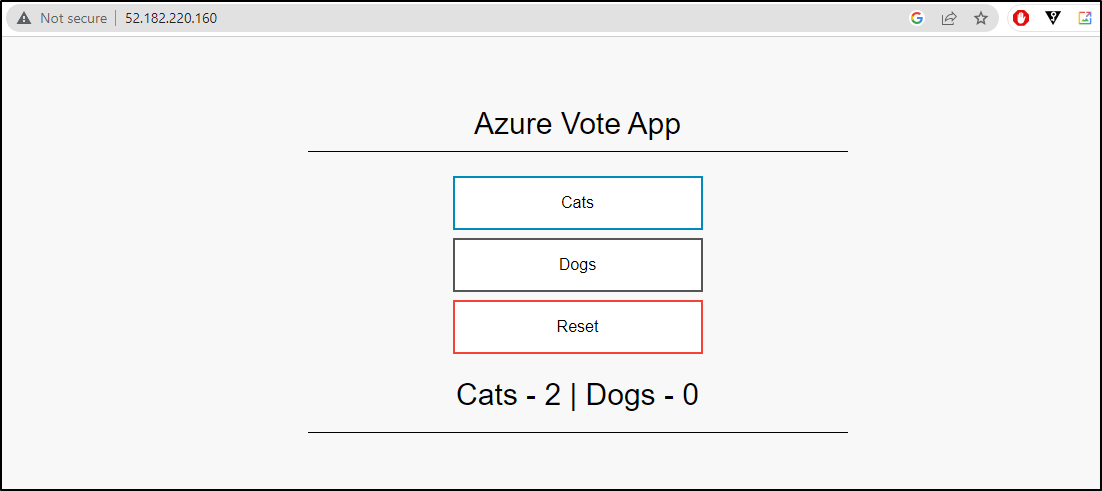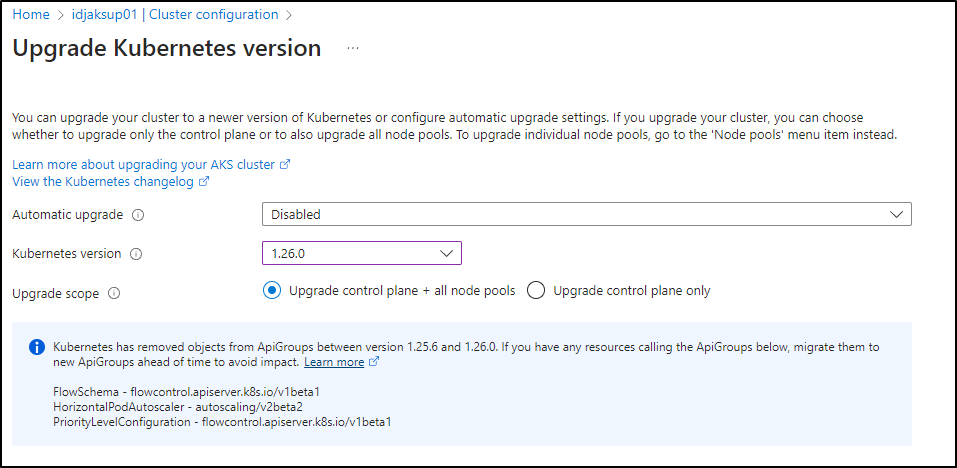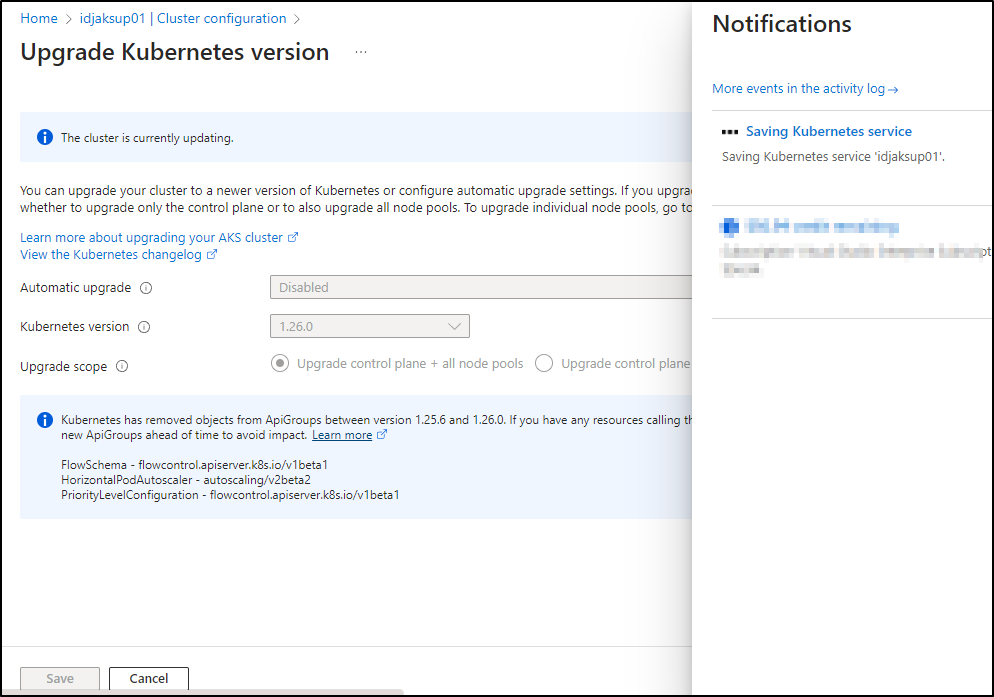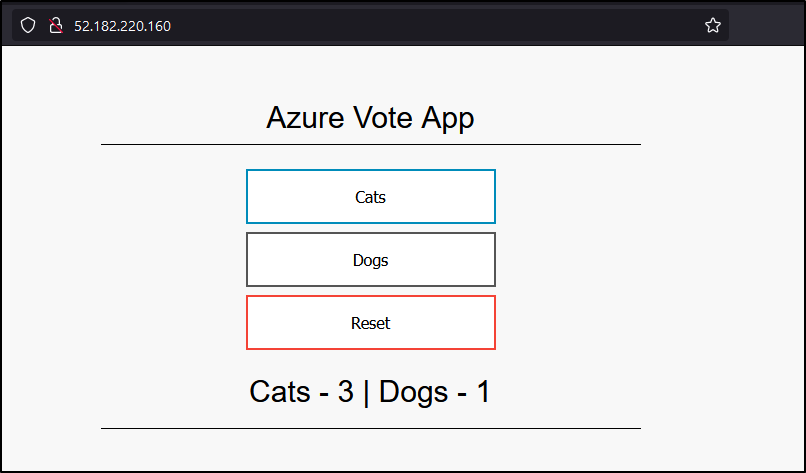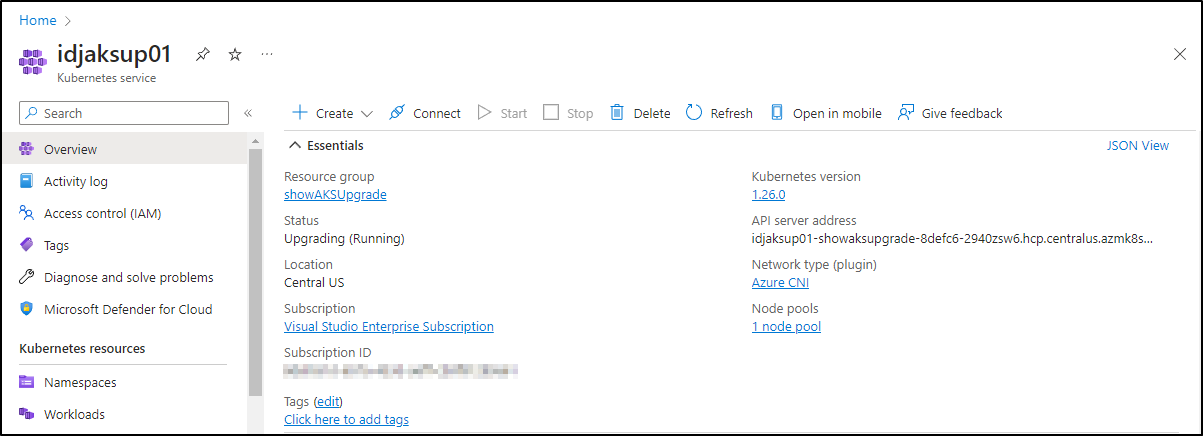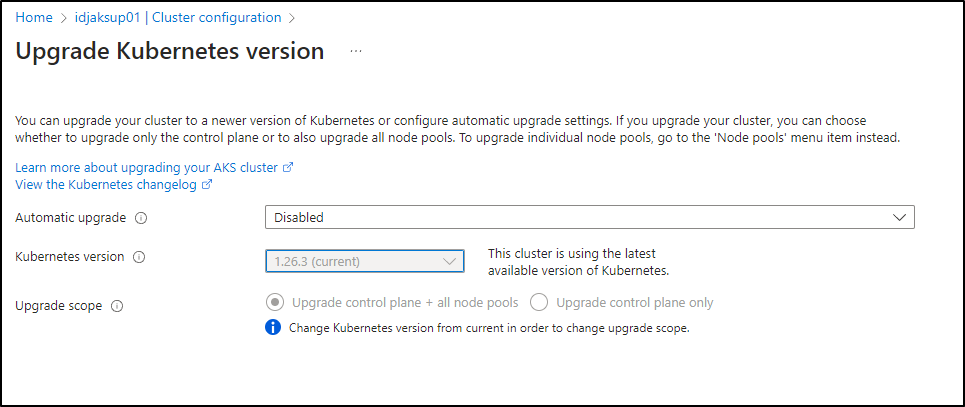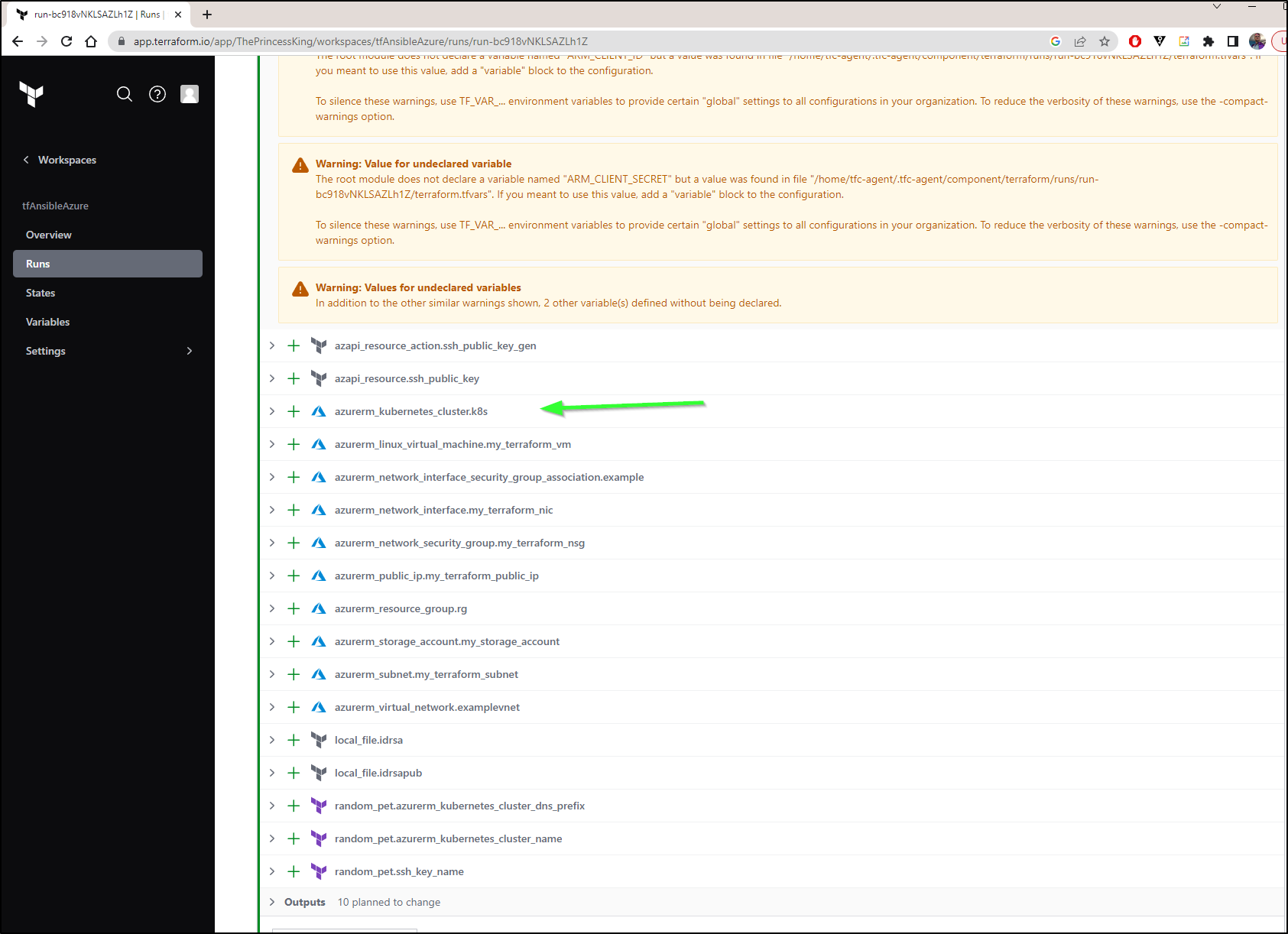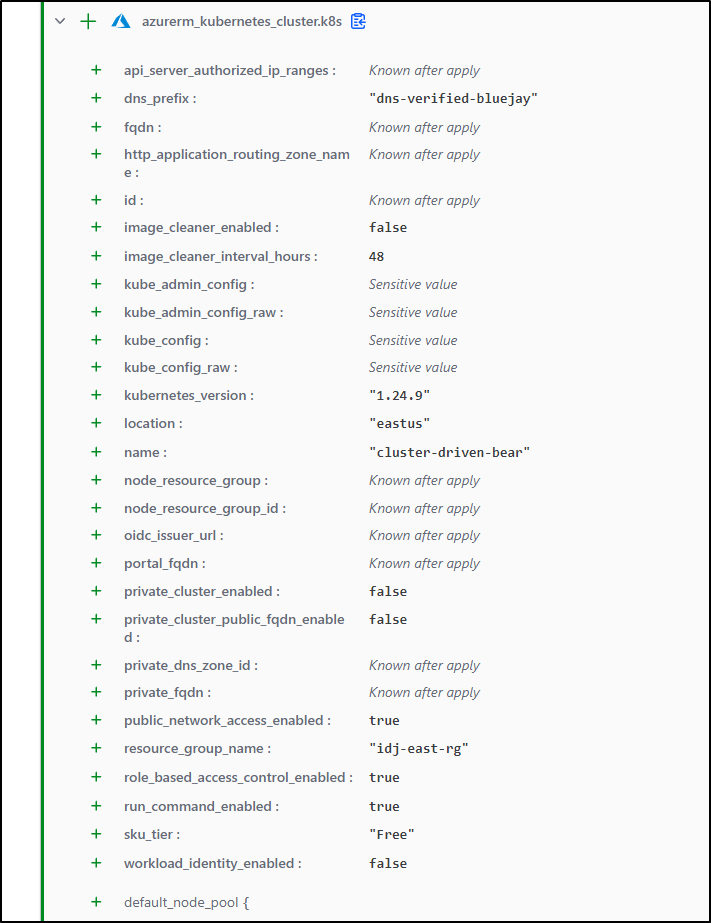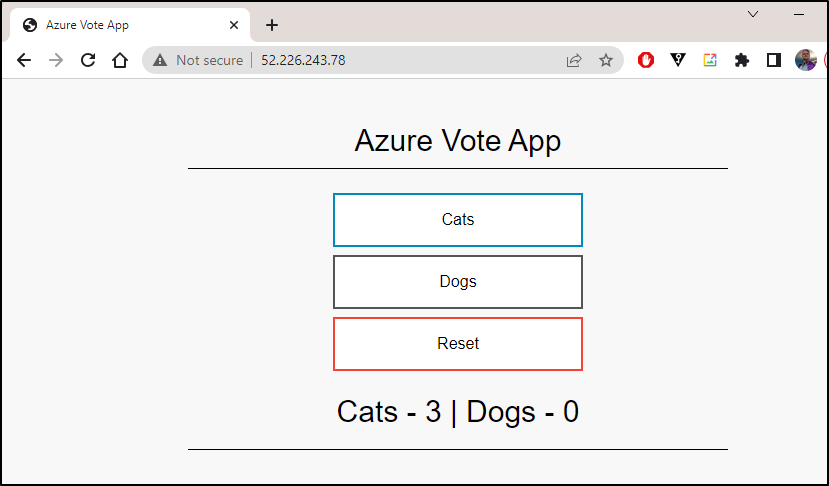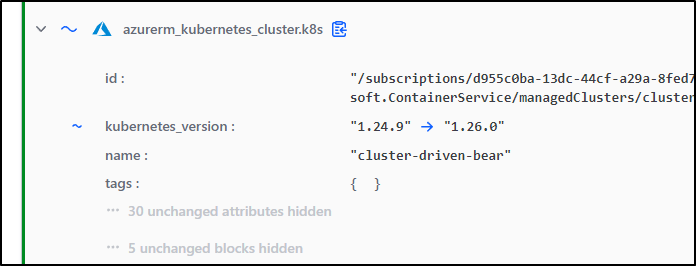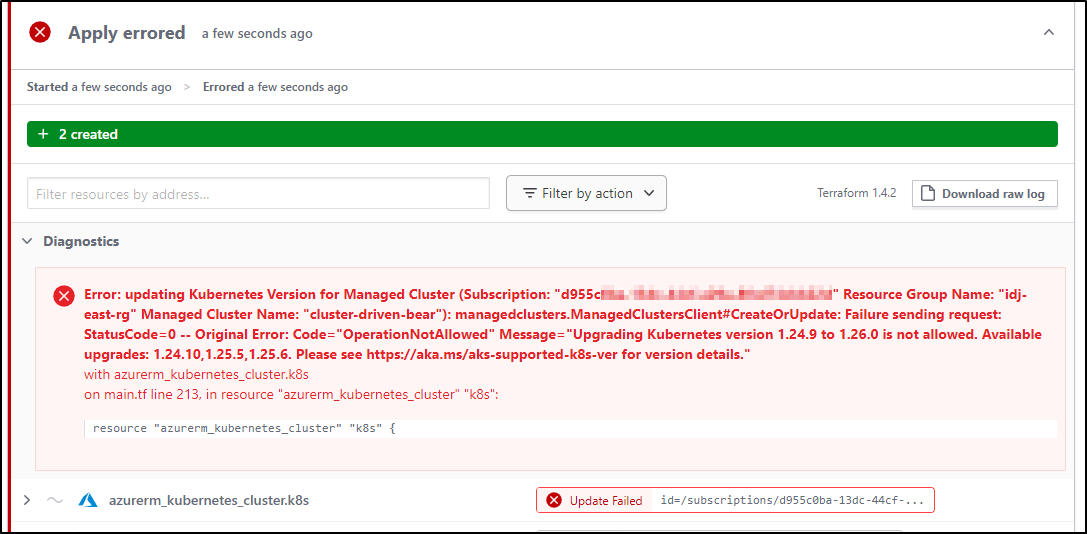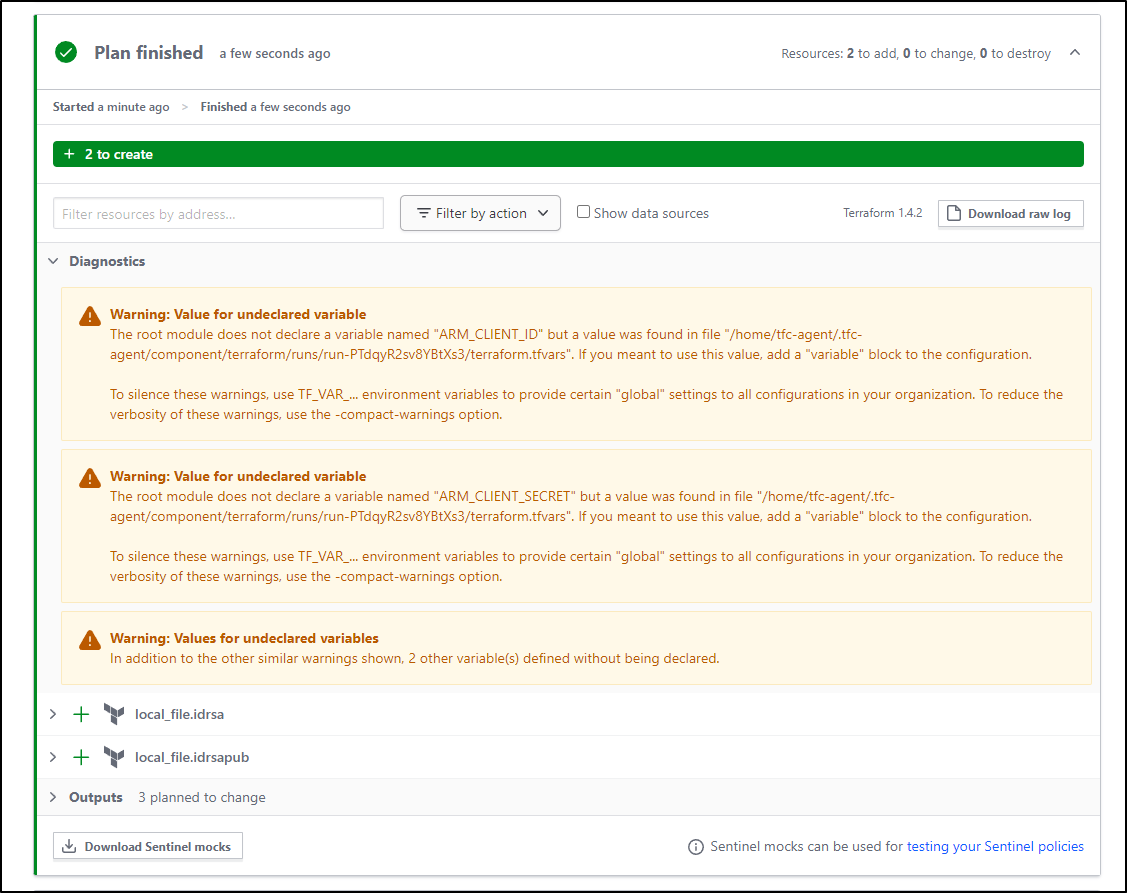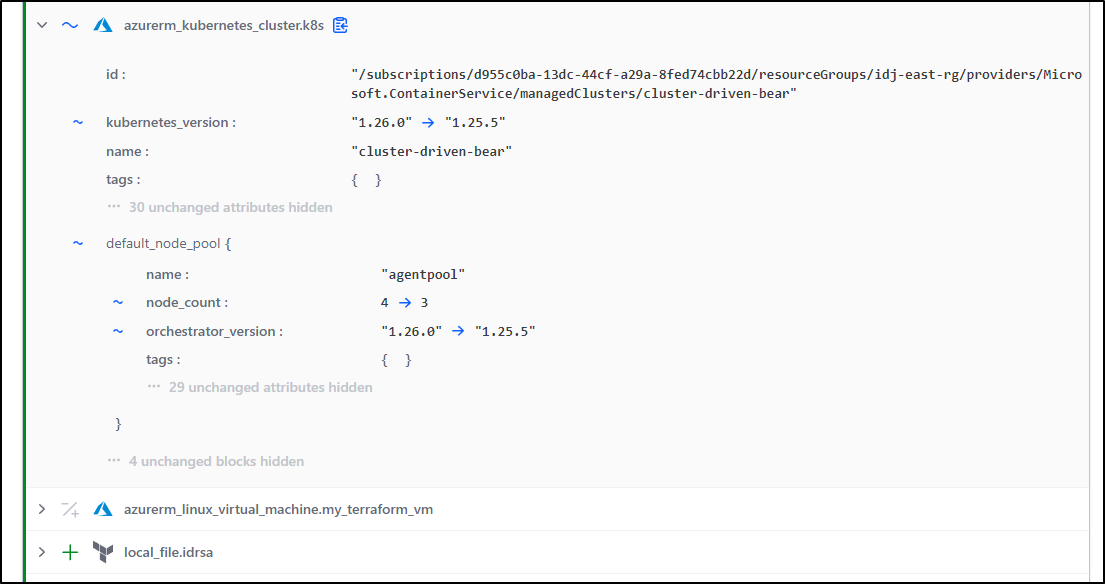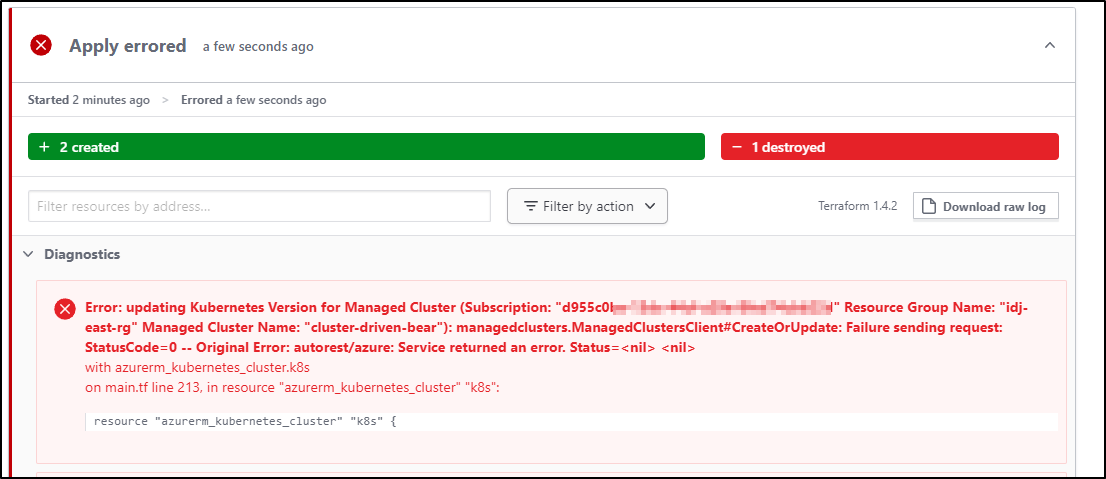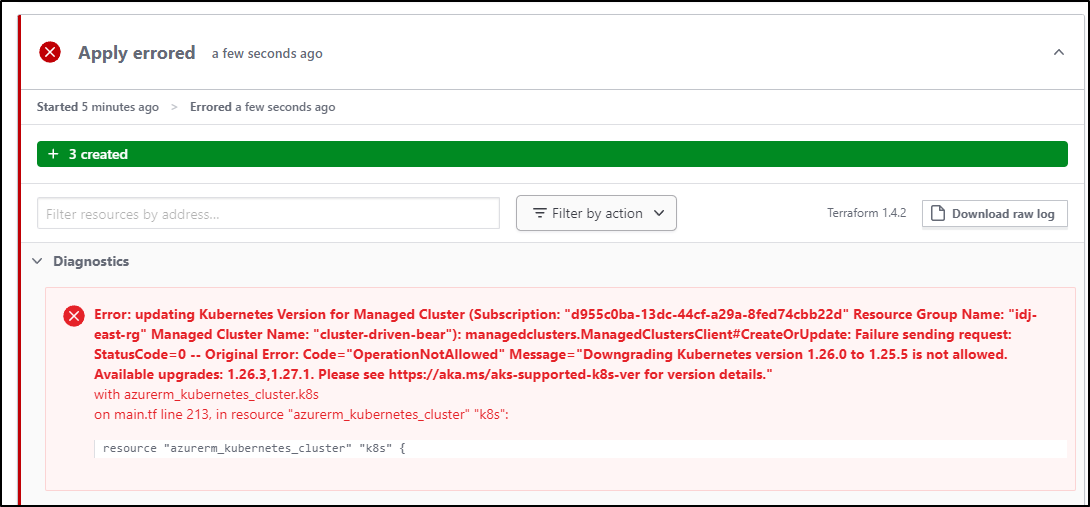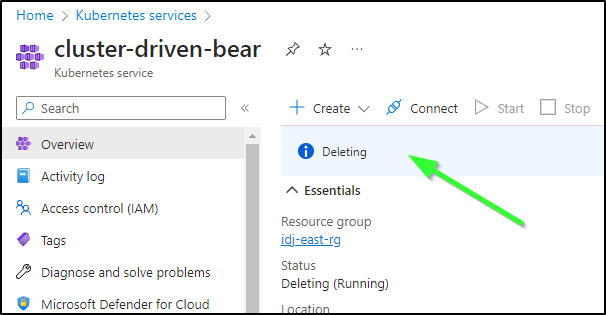Published: Jun 23, 2023 by Isaac Johnson
This topic of AKS Upgrades has come up a few times for me lately. Questions around how to upgrade, what is affected, how to check and rotate SP IDs. I figured it might be nice to just write it up for all.
We will cover AKS via the CLI, Portal and Terraform (Using TF Cloud). We’ll run some live experiments and cover many different upgrade scenarios.
Creating an AKS cluster
Let’s just create a cluster. To keep it simple, we’ll use the AZ CLI
Resource Group
First, I create a Resource Group
$ az login
$ az account set --subscription 2f0469bd-d00c-4411-85e6-369915da6e54
$ az group create --name showAKSUpgrade --location centralus
Service Principal
Next, I’ll want to create a Service Principal (SP) (aka App Registration) I can use for the cluster
$ az ad sp create-for-rbac -n idjaksupg01sp --skip-assignment --output json
Option '--skip-assignment' has been deprecated and will be removed in a future release.
The output includes credentials that you must protect. Be sure that you do not include these credentials in your code or check the credentials into your source control. For more information, see https://aka.ms/azadsp-cli
{
"appId": "12c57d86-8cc1-4da4-b0ff-b38dc97ab02d",
"displayName": "idjaksupg01sp",
"password": "dGhpcyBpcyBhIHBhc3N3b3JkIGJ1dCBub3QgdGhlIG9uZSB0aGF0IGlzIHJlYWwK",
"tenant": "da4e9527-0d2b-4842-a1f2-f47cb15531de"
}
$ export SP_PASS="dGhpcyBpcyBhIHBhc3N3b3JkIGJ1dCBub3QgdGhlIG9uZSB0aGF0IGlzIHJlYWwK"
$ export SP_ID="12c57d86-8cc1-4da4-b0ff-b38dc97ab02d"
Generally, I save the SP creds into a file and use that for env vars
$ az ad sp create-for-rbac -n idjaksupg01sp --skip-assignment --output json > my_sp.json$ cat my_sp.json | jq -r .appId
12c57d86-8cc1-4da4-b0ff-b38dc97ab02d
I can then set the ID and PASS on the fly
$ export SP_PASS=`cat my_sp.json | jq -r .password`
$ export SP_ID=`cat my_sp.json | jq -r .appId`
Whether you pipe to a JSON or you set manually, the next steps assume you set SP_ID and SP_PASS.
Create Cluster
Next, I’ll create an autoscaling cluster
$ az aks create --resource-group showAKSUpgrade --name idjaksup01 --location centralus --node-count 3 --enable-cluster-autoscaler --min-count 2 --max-count 4 --generate-ssh-keys --network-plugin azure --network-policy azure --service-principal $SP_ID --client-secret $SP_PASS
Once created, I can list it
$ az aks list -o table
Name Location ResourceGroup KubernetesVersion CurrentKubernetesVersion ProvisioningState Fqdn
---------- ---------- --------------- ------------------- -------------------------- ------------------- -----------------------------------------------------------------
idjaksup01 centralus showAKSUpgrade 1.25.6 1.25.6 Succeeded idjaksup01-showaksupgrade-8defc6-2940zsw6.hcp.centralus.azmk8s.io
Finding your SP ID
Assuming you are coming back to a cluster, how might you find the Service Principal ID it uses?
One easy way is to use the AZ CLI
az aks show -n idjaksup01 -g showAKSUpgrade --query servicePrincipalProfile.clientId -o tsv
12c57d86-8cc1-4da4-b0ff-b38dc97ab02d
Rotating a Cred
Assuming we want to expire and rotate the Service Principal client secret, we can just ask for a new ID
$ export SP_ID=`az aks show --resource-group showAKSUpgrade --name idjaksup01 --query servicePrincipalProfile.clientId -o tsv`
Alternatively, you can go to AAD and find your App Registration
Then create a new secret under secrets to use (you can also see the expiry on former secrets)
Applying to the Cluster
Let’s now apply the new SP Secret to the cluster
I’ll rotate and apply as two steps
$ export SP_NEW_SECRET=`az ad app credential reset --id "$SP_ID" --query password -o tsv`
$ az aks update-credentials -g showAKSUpgrade -n idjaksup01 --reset-service-principal --service-principal "$SP_ID" --client-secret "$SP_NEW_SECRET"
This step will take a while so be patient.
Verification
We can check our secrets by fetching AAD details from a CSI pod.
We first want to login to the cluster
$ az aks get-credentials -g showAKSUpgrade -n idjaksup01 --admin
Merged "idjaksup01-admin" as current context in /home/builder/.kube/config
Then let’s find one of the CSI pods
$ kubectl get pods -l app=csi-azuredisk-node -n kube-system
NAME READY STATUS RESTARTS AGE
csi-azuredisk-node-88sxc 3/3 Running 0 3d13h
csi-azuredisk-node-hw95j 3/3 Running 0 3d13h
We can now fetch and check the SP ID and PASS
$ kubectl exec -it --container azuredisk -n kube-system csi-azuredisk-node-88sxc -- cat /etc/kubernetes/azure.json
{
"cloud": "AzurePublicCloud",
"tenantId": "da4e9527-0d2b-4842-a1f2-f47cb15531de",
"subscriptionId": "2f0469bd-d00c-4411-85e6-369915da6e54",
"aadClientId": "12c57d86-8cc1-4da4-b0ff-b38dc97ab02d",
"aadClientSecret": "bm90IG15IHNlY3JldCwgYnV0IHRoYW5rcyBmb3IgY2hlY2tpbmcK",
"resourceGroup": "MC_showAKSUpgrade_idjaksup01_centralus",
"location": "centralus",
"vmType": "vmss",
"subnetName": "aks-subnet",
"securityGroupName": "aks-agentpool-25858899-nsg",
"vnetName": "aks-vnet-25858899",
"vnetResourceGroup": "",
"routeTableName": "aks-agentpool-25858899-routetable",
"primaryAvailabilitySetName": "",
"primaryScaleSetName": "aks-nodepool1-28899529-vmss",
"cloudProviderBackoffMode": "v2",
"cloudProviderBackoff": true,
"cloudProviderBackoffRetries": 6,
"cloudProviderBackoffDuration": 5,
"cloudProviderRateLimit": true,
"cloudProviderRateLimitQPS": 10,
"cloudProviderRateLimitBucket": 100,
"cloudProviderRateLimitQPSWrite": 10,
"cloudProviderRateLimitBucketWrite": 100,
"useManagedIdentityExtension": false,
"userAssignedIdentityID": "",
"useInstanceMetadata": true,
"loadBalancerSku": "Standard",
"disableOutboundSNAT": false,
"excludeMasterFromStandardLB": true,
"providerVaultName": "",
"maximumLoadBalancerRuleCount": 250,
"providerKeyName": "k8s",
"providerKeyVersion": ""
}
The values above we care about are
"aadClientId": "12c57d86-8cc1-4da4-b0ff-b38dc97ab02d",
"aadClientSecret": "bm90IG15IHNlY3JldCwgYnV0IHRoYW5rcyBmb3IgY2hlY2tpbmcK",
AKS Upgrades
We can upgrade a cluster two ways.
The first is using the Azure Portal. We’ll look it up under “Cluster configuration” in “Settings”
If you have multiple node pools or manual ones, you can chose to do the Control Plane (master nodes) first.
Clicking the drop down shows all the versions we can go to presently (not all that are out there). AKS can upgrade one major release at a time
Azure will tell us what to watch out for; namely that a few APIs are being deprecated
Kubernetes has removed objects from ApiGroups between version 1.25.6 and 1.26.3. If you have any resources calling the ApiGroups below, migrate them to new ApiGroups ahead of time to avoid impact.Learn more
FlowSchema - flowcontrol.apiserver.k8s.io/v1beta1
HorizontalPodAutoscaler - autoscaling/v2beta2
PriorityLevelConfiguration - flowcontrol.apiserver.k8s.io/v1beta1
As I want to see some effects, let’s pause for a moment and install a sample app
Azure Vote App
Note: this ultimately did not create an App with deprecated APIs, but is a nice app we can use to watch our upgrades
I’ll add the Sample Repo and update, in case I haven’t yet
$ helm repo add azure-samples https://azure-samples.github.io/helm-charts/
"azure-samples" already exists with the same configuration, skipping
$ helm repo update
Hang tight while we grab the latest from your chart repositories...
...Successfully got an update from the "kube-state-metrics" chart repository
...Successfully got an update from the "myharbor" chart repository
...Successfully got an update from the "freshbrewed" chart repository
...Successfully got an update from the "longhorn" chart repository
...Successfully got an update from the "actions-runner-controller" chart repository
...Successfully got an update from the "adwerx" chart repository
...Successfully got an update from the "confluentinc" chart repository
...Successfully got an update from the "kuma" chart repository
...Successfully got an update from the "hashicorp" chart repository
...Successfully got an update from the "dapr" chart repository
...Successfully got an update from the "akomljen-charts" chart repository
...Successfully got an update from the "kubecost" chart repository
...Successfully got an update from the "opencost" chart repository
...Successfully got an update from the "sumologic" chart repository
...Successfully got an update from the "zabbix-community" chart repository
...Successfully got an update from the "sonarqube" chart repository
...Successfully got an update from the "castai-helm" chart repository
...Successfully got an update from the "jfelten" chart repository
...Successfully got an update from the "azure-samples" chart repository
...Successfully got an update from the "nginx-stable" chart repository
...Successfully got an update from the "novum-rgi-helm" chart repository
...Successfully got an update from the "kiwigrid" chart repository
...Successfully got an update from the "rhcharts" chart repository
...Successfully got an update from the "epsagon" chart repository
...Successfully got an update from the "datadog" chart repository
...Successfully got an update from the "lifen-charts" chart repository
...Successfully got an update from the "rook-release" chart repository
...Successfully got an update from the "elastic" chart repository
...Successfully got an update from the "argo-cd" chart repository
...Successfully got an update from the "harbor" chart repository
...Successfully got an update from the "signoz" chart repository
...Successfully got an update from the "crossplane-stable" chart repository
...Successfully got an update from the "newrelic" chart repository
...Successfully got an update from the "incubator" chart repository
...Successfully got an update from the "grafana" chart repository
...Successfully got an update from the "uptime-kuma" chart repository
...Successfully got an update from the "gitlab" chart repository
...Successfully got an update from the "bitnami" chart repository
...Successfully got an update from the "ngrok" chart repository
...Successfully got an update from the "open-telemetry" chart repository
...Successfully got an update from the "rancher-latest" chart repository
...Successfully got an update from the "prometheus-community" chart repository
Update Complete. ⎈Happy Helming!⎈
Next I’ll add the vote app
$ helm install azure-samples/azure-vote --generate-name
NAME: azure-vote-1687260329
LAST DEPLOYED: Tue Jun 20 06:25:30 2023
NAMESPACE: default
STATUS: deployed
REVISION: 1
TEST SUITE: None
NOTES:
The Azure Vote application has been started on your Kubernetes cluster.
Title: Azure Vote App
Vote 1 value: Cats
Vote 2 value: Dogs
The externally accessible IP address can take a minute or so to provision. Run the following command to monitor the provisioning status. Once an External IP address has been provisioned, brows to this IP address to access the Azure Vote application.
kubectl get service -l name=azure-vote-front -w
I can now get the LB IP and view the app
$ kubectl get service -l name=azure-vote-front
NAME TYPE CLUSTER-IP EXTERNAL-IP PORT(S) AGE
azure-vote-front LoadBalancer 10.0.217.17 52.182.220.160 80:30425/TCP 24s
Let’s now add an HPA on the front end
$ kubectl get deployment
NAME READY UP-TO-DATE AVAILABLE AGE
vote-back-azure-vote-1687260329 1/1 1 1 76s
vote-front-azure-vote-1687260329 1/1 1 1 76s
$ kubectl autoscale deployment vote-back-azure-vote-1687260329 --cpu-percent=50 --min=3 --max=10
horizontalpodautoscaler.autoscaling/vote-back-azure-vote-1687260329 autoscaled
I was hoping for a good demo of deprecated APIs, but it seems AKS v1.25 was already set to use the new APIs
builder@DESKTOP-QADGF36:~$ kubectl api-resources | grep autosc
horizontalpodautoscalers hpa autoscaling/v2 true HorizontalPodAutoscaler
builder@DESKTOP-QADGF36:~$ kubectl api-resources | grep flow
flowschemas flowcontrol.apiserver.k8s.io/v1beta2 false FlowSchema
prioritylevelconfigurations flowcontrol.apiserver.k8s.io/v1beta2 false PriorityLevelConfiguration
builder@DESKTOP-QADGF36:~$ kubectl api-resources | grep priority
prioritylevelconfigurations flowcontrol.apiserver.k8s.io/v1beta2 false PriorityLevelConfiguration
priorityclasses pc scheduling.k8s.io/v1 false PriorityClass
To ensure we have a deprecated API involved, I’ll manually create the HPA for the Front end using YAML
$ cat avf.hpa.yaml
apiVersion: autoscaling/v2beta2
kind: HorizontalPodAutoscaler
metadata:
name: vote-front-azure-vote-1687260329
namespace: default
spec:
maxReplicas: 10
metrics:
- resource:
name: cpu
target:
averageUtilization: 50
type: Utilization
type: Resource
minReplicas: 3
scaleTargetRef:
apiVersion: apps/v1
kind: Deployment
name: vote-front-azure-vote-1687260329
$ kubectl apply -f avf.hpa.yaml
Warning: autoscaling/v2beta2 HorizontalPodAutoscaler is deprecated in v1.23+, unavailable in v1.26+; use autoscaling/v2 HorizontalPodAutoscaler
horizontalpodautoscaler.autoscaling/vote-front-azure-vote-1687260329 created
Only, AKS caught it and used the newer API!
$ kubectl get hpa vote-front-azure-vote-1687260329
NAME REFERENCE TARGETS MINPODS MAXPODS REPLICAS AGE
vote-front-azure-vote-1687260329 Deployment/vote-front-azure-vote-1687260329 0%/50% 3 10 3 47s
$ kubectl get hpa vote-front-azure-vote-1687260329 -o yaml
apiVersion: autoscaling/v2
kind: HorizontalPodAutoscaler
metadata:
annotations:
... snip ...
What about the other APIs?
Flow schema is good (at v1beta2 not v1beta1)
$ kubectl get flowschema --all-namespaces
NAME PRIORITYLEVEL MATCHINGPRECEDENCE DISTINGUISHERMETHOD AGE MISSINGPL
exempt exempt 1 <none> 3d14h False
probes exempt 2 <none> 3d14h False
system-leader-election leader-election 100 ByUser 3d14h False
endpoint-controller workload-high 150 ByUser 3d14h False
workload-leader-election leader-election 200 ByUser 3d14h False
system-node-high node-high 400 ByUser 3d14h False
system-nodes system 500 ByUser 3d14h False
kube-controller-manager workload-high 800 ByNamespace 3d14h False
kube-scheduler workload-high 800 ByNamespace 3d14h False
kube-system-service-accounts workload-high 900 ByNamespace 3d14h False
service-accounts workload-low 9000 ByUser 3d14h False
global-default global-default 9900 ByUser 3d14h False
catch-all catch-all 10000 ByUser 3d14h False
$ kubectl get flowschema system-leader-election -o yaml
apiVersion: flowcontrol.apiserver.k8s.io/v1beta2
kind: FlowSchema
metadata:
annotations:
As is priority level
$ kubectl get PriorityLevelConfiguration
NAME TYPE ASSUREDCONCURRENCYSHARES QUEUES HANDSIZE QUEUELENGTHLIMIT AGE
catch-all Limited 5 <none> <none> <none> 3d14h
exempt Exempt <none> <none> <none> <none> 3d14h
global-default Limited 20 128 6 50 3d14h
leader-election Limited 10 16 4 50 3d14h
node-high Limited 40 64 6 50 3d14h
system Limited 30 64 6 50 3d14h
workload-high Limited 40 128 6 50 3d14h
workload-low Limited 100 128 6 50 3d14h
$ kubectl get PriorityLevelConfiguration global-default -o yaml
apiVersion: flowcontrol.apiserver.k8s.io/v1beta2
kind: PriorityLevelConfiguration
metadata:
annotations:
...
Upgrading
Regardless of not finding a good way to create deprecated APIs, let’s complete the upgrade
I’ll go to 1.26.0 so I can use the CLI next
In saving, we start the upgrade
We can then see it start to rotate in new nodes and move workloads.
Never during the process does our app actually go down
I pannicked when Chrome started to get an internal server error, but I couldnt find errors in the Kuberenetes logs and firing up an alternate browser showed things were fine
And we can see it is done both in the Azure Portal
Control Plane:
Node Pools:
As well as on the command line
$ az aks list -o table
Name Location ResourceGroup KubernetesVersion CurrentKubernetesVersion ProvisioningState Fqdn
---------- ---------- --------------- ------------------- -------------------------- ------------------- -----------------------------------------------------------------
idjaksup01 centralus showAKSUpgrade 1.26.0 1.26.0 Succeeded idjaksup01-showaksupgrade-8defc6-2940zsw6.hcp.centralus.azmk8s.io
$ kubectl get nodes
NAME STATUS ROLES AGE VERSION
aks-nodepool1-28899529-vmss000000 Ready agent 9m14s v1.26.0
aks-nodepool1-28899529-vmss000001 Ready agent 5m35s v1.26.0
Using CLI
Let’s use the CLI this time.
We can ask for what is available
$ az aks get-upgrades -g showAKSUpgrade -n idjaksup01 -o table
Name ResourceGroup MasterVersion Upgrades
------- --------------- --------------- ----------
default showAKSUpgrade 1.26.0 1.26.3
It does warn of blips and confirms I want to do both…
$ az aks upgrade -g showAKSUpgrade -n idjaksup01 --kubernetes-version 1.26.3
Kubernetes may be unavailable during cluster upgrades.
Are you sure you want to perform this operation? (y/N): y
Since control-plane-only argument is not specified, this will upgrade the control plane AND all nodepools to version 1.26.3. Continue? (y/N): y
\ Running ..
While that is running, we can use kubectl get events -w to watch events
15m Warning FailedGetResourceMetric horizontalpodautoscaler/vote-front-azure-vote-1687260329 failed to get cpu utilization: unable to get metrics for resource cpu: unable to fetch metrics from resource metrics API: the server is currently unable to handle the request (get pods.metrics.k8s.io)
15m Warning FailedComputeMetricsReplicas horizontalpodautoscaler/vote-front-azure-vote-1687260329 invalid metrics (1 invalid out of 1), first error is: failed to get cpu resource metric value: failed to get cpu utilization: unable to get metrics for resource cpu: unable to fetch metrics from resource metrics API: the server is currently unable to handle the request (get pods.metrics.k8s.io)
5m11s Warning FailedGetResourceMetric horizontalpodautoscaler/vote-front-azure-vote-1687260329 failed to get cpu utilization: did not receive metrics for any ready pods
5m11s Warning FailedComputeMetricsReplicas horizontalpodautoscaler/vote-front-azure-vote-1687260329 invalid metrics (1 invalid out of 1), first error is: failed to get cpu resource metric value: failed to get cpu utilization: did not receive metrics for any ready pods
0s Normal Starting node/aks-nodepool1-28899529-vmss000001
0s Warning FailedGetResourceMetric horizontalpodautoscaler/vote-front-azure-vote-1687260329 failed to get cpu utilization: unable to get metrics for resource cpu: unable to fetch metrics from resource metrics API: the server is currently unable to handle the request (get pods.metrics.k8s.io)
0s Warning FailedComputeMetricsReplicas horizontalpodautoscaler/vote-front-azure-vote-1687260329 invalid metrics (1 invalid out of 1), first error is: failed to get cpu resource metric value: failed to get cpu utilization: unable to get metrics for resource cpu: unable to fetch metrics from resource metrics API: the server is currently unable to handle the request (get pods.metrics.k8s.io)
0s Normal Starting node/aks-nodepool1-28899529-vmss000000
You can watch it happen here if you want to see the process:
No Upgrades
If you are at the latest, it’s worth noting the “upgrades” field will be null
$ az aks get-upgrades -g showAKSUpgrade -n idjaksup01 -o table
Table output unavailable. Use the --query option to specify an appropriate query. Use --debug for more info.
$ az aks get-upgrades -g showAKSUpgrade -n idjaksup01
{
"agentPoolProfiles": null,
"controlPlaneProfile": {
"kubernetesVersion": "1.26.3",
"name": null,
"osType": "Linux",
"upgrades": null
},
... snip ...
And the portal will say the same
Terraform
First, we’ll need to know what versions we can use in a region. I’ll be using “East US”, so let’s check what is supported there presently
$ az aks get-versions --location eastus --output table
KubernetesVersion Upgrades
------------------- -----------------------
1.27.1(preview) None available
1.26.3 1.27.1(preview)
1.26.0 1.26.3, 1.27.1(preview)
1.25.6 1.26.0, 1.26.3
1.25.5 1.25.6, 1.26.0, 1.26.3
1.24.10 1.25.5, 1.25.6
1.24.9 1.24.10, 1.25.5, 1.25.6
Since I want to test upgrades, I’ll choose the lowest version (1.24.9 ).
I’ll set that in a variable
variable "kubernetes_version" {
type = string
default = "1.24.9 "
description = "The specific version of Kubernetes to use."
}
Which I can use in my Kubernetes TF
resource "azurerm_kubernetes_cluster" "k8s" {
location = azurerm_resource_group.rg.location
name = random_pet.azurerm_kubernetes_cluster_name.id
resource_group_name = azurerm_resource_group.rg.name
dns_prefix = random_pet.azurerm_kubernetes_cluster_dns_prefix.id
kubernetes_version = var.kubernetes_version
identity {
type = "SystemAssigned"
}
default_node_pool {
name = "agentpool"
vm_size = "Standard_D2_v2"
node_count = var.node_count
}
linux_profile {
admin_username = "ubuntu"
ssh_key {
key_data = jsondecode(azapi_resource_action.ssh_public_key_gen.output).publicKey
}
}
network_profile {
network_plugin = "kubenet"
load_balancer_sku = "standard"
}
}
I wanted to quick sanity check the sizes in the region in case Standard_D2_v2 is no longer there
$ az vm list-sizes --location eastus -o table | grep Standard_D2_v2
8 7168 Standard_D2_v2 2 1047552 102400
8 7168 Standard_D2_v2_Promo 2 1047552 102400
I now have a TF Cloud plan to run
The first time through I made a typo on version (“1.24.9 “ with extra space). If you use an errant version, you’ll get an error such as
Failure sending request: StatusCode=0 -- Original Error: Code="BadRequest" Message="Client Error: error parsing version(1.24.9 ) as semver: Invalid characters in version"
While it is still creating in TF Cloud, I can see it exists in Azure already
$ az aks list -o table
Name Location ResourceGroup KubernetesVersion CurrentKubernetesVersion ProvisioningState Fqdn
------------------- ---------- --------------- ------------------- -------------------------- ------------------- --------------------------------------------------
cluster-driven-bear eastus idj-east-rg 1.24.9 1.24.9 Creating dns-verified-bluejay-q17kaixm.hcp.eastus.azmk8s.io
And when the run is done, I see that in TF Cloud as well
I’ll now add an app so we can see some data
$ az aks get-credentials -n cluster-driven-bear -g idj-east-rg --admin
Merged "cluster-driven-bear-admin" as current context in /home/builder/.kube/config
$ helm install azure-samples/azure-vote --generate-name
NAME: azure-vote-1687520242
LAST DEPLOYED: Fri Jun 23 06:37:23 2023
NAMESPACE: default
STATUS: deployed
REVISION: 1
TEST SUITE: None
NOTES:
The Azure Vote application has been started on your Kubernetes cluster.
Title: Azure Vote App
Vote 1 value: Cats
Vote 2 value: Dogs
The externally accessible IP address can take a minute or so to provision. Run the following command to monitor the provisioning status. Once an External IP address has been provisioned, brows to this IP address to access the Azure Vote application.
kubectl get service -l name=azure-vote-front -w
$ kubectl get service -l name=azure-vote-front
NAME TYPE CLUSTER-IP EXTERNAL-IP PORT(S) AGE
azure-vote-front LoadBalancer 10.0.133.63 52.226.243.78 80:30747/TCP 33s
Upgrade Scenario 1: Upgrading with TF
Let’s say we want to upgrade using terraform.
I’ll first try something that should fail - upgrading more than one version up
$ git diff
diff --git a/variables.tf b/variables.tf
index 2e05a73..5524567 100644
--- a/variables.tf
+++ b/variables.tf
@@ -29,7 +29,7 @@ variable "msi_id" {
variable "kubernetes_version" {
type = string
- default = "1.24.9"
+ default = "1.26.0"
description = "The specific version of Kubernetes to use."
}
The plan thinks this will work
However, the apply catches it and errors, as I would expect
Applying with the proper version works, but unless I call out the node pool versions, I had to upgrade them via the Portal (it only updated the Control Plane).
We can do the node pools at the same time using orchestrator_version
$ git diff
diff --git a/main.tf b/main.tf
index f3a3c5e..4de9093 100644
--- a/main.tf
+++ b/main.tf
@@ -222,9 +222,10 @@ resource "azurerm_kubernetes_cluster" "k8s" {
}
default_node_pool {
- name = "agentpool"
- vm_size = "Standard_D2_v2"
- node_count = var.node_count
+ name = "agentpool"
+ vm_size = "Standard_D2_v2"
+ node_count = var.node_count
+ orchestrator_version = var.kubernetes_version
}
linux_profile {
admin_username = "ubuntu"
In fact, setting them now didn’t even show a thing to change in the plan
Upgrade Scenario 2: Upgrading outside of TF
The other way we can go about this is to do our upgrades in the Portal or external to Terraform and then update terraform to match (and then get our state updated for us). It would be effectively a no-op plan and apply.
The first check is to upgrade via the portal:
and see what happens when we don’t adjust the terraform to match.
Here I’ll update a setting on a VM, not touching anything with the AKS cluster
$ git diff
diff --git a/main.tf b/main.tf
index 4de9093..0f95986 100644
--- a/main.tf
+++ b/main.tf
@@ -165,7 +165,7 @@ resource "azurerm_linux_virtual_machine" "my_terraform_vm" {
computer_name = "myvm"
admin_username = "azureuser"
- disable_password_authentication = true
+ disable_password_authentication = false
admin_ssh_key {
username = "azureuser"
$ git add main.tf
$ git commit -m "non AKS Change"
[clone_with_github d73c343] non AKS Change
1 file changed, 1 insertion(+), 1 deletion(-)
$ git push
Enumerating objects: 5, done.
Counting objects: 100% (5/5), done.
Delta compression using up to 16 threads
Compressing objects: 100% (3/3), done.
Writing objects: 100% (3/3), 303 bytes | 303.00 KiB/s, done.
Total 3 (delta 2), reused 0 (delta 0)
remote: Resolving deltas: 100% (2/2), completed with 2 local objects.
To https://github.com/idjohnson/tfAnsibleAzure.git
a5eab90..d73c343 clone_with_github -> clone_with_github
Sadly, it appears it wants to downgrade (but this should be blocked on apply)
Which it did (though sort of an odd error)
I think the strange error was because the plan kicked off while the cluster was not done upgrading. Doing it a second time gave me more reasonable error message: “Downgrading Kubernetes version 1.26.0 to 1.25.5 is not allowed. Available upgrades: 1.26.3,1.27.1. Please see https://aka.ms/aks-supported-k8s-ver for version details.”
That said, I can update Terraform to match the new portal versions and it’s happy again.
Cleanup
Assuming you don’t want to keep the cluster from our CLI steps, you can delete the cluster to save money
$ az aks delete -g showAKSUpgrade -n idjaksup01
Are you sure you want to perform this operation? (y/n): y
- Running ..
As well as the group
$ az group delete --resource-group showAKSUpgrade
Are you sure you want to perform this operation? (y/n): y
In Terraform, we comment it out to remove
which should remove it via TF Cloud
And we can see it get removed via the Azure Portal as well
Summary
We did two AKS upgrades, we showed how to find and rotate the Service Principal ID and we attempted to load some deprecated APIs. While we weren’t able to really show deprecation handling (AKS will upgrade it, i might add - we would have seen that), we did see the full upgrade flow.
We also tested how this works with Terraform using Terraform Cloud. We tested a few scenarios including trying to upgrade too far, not updating the versions after portal upgrade and more.
Hopefully this guide assuages any fears one might have about Azure Kubernetes Service and it’s upgrade process.



